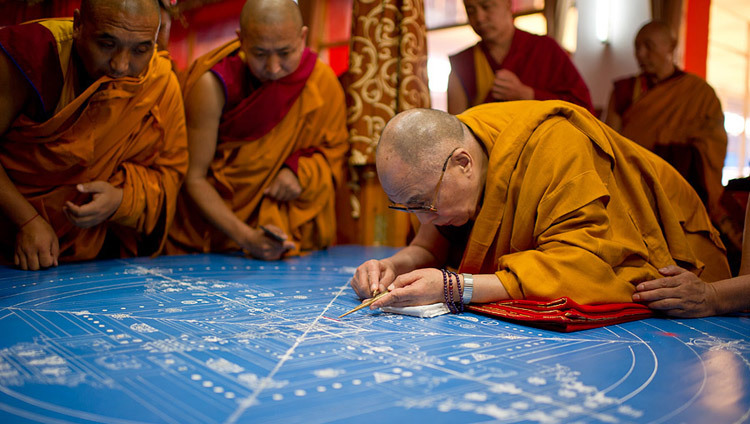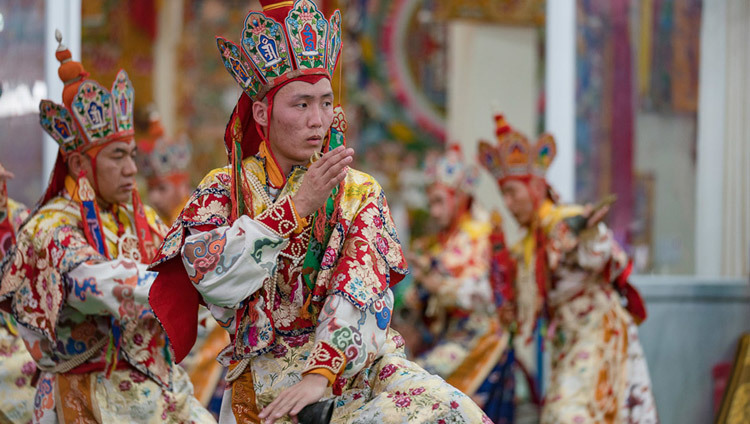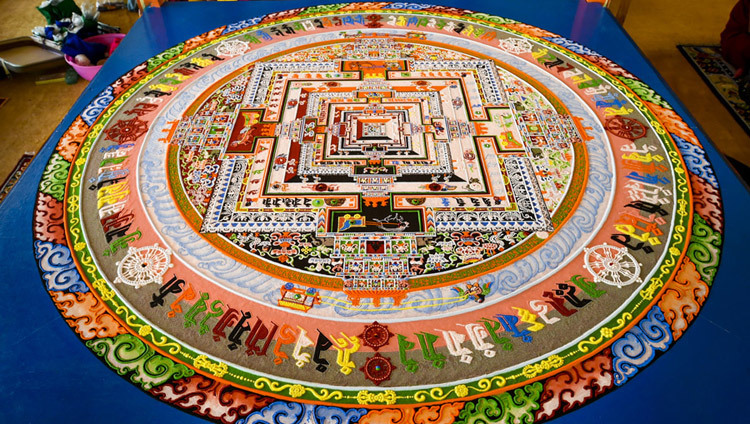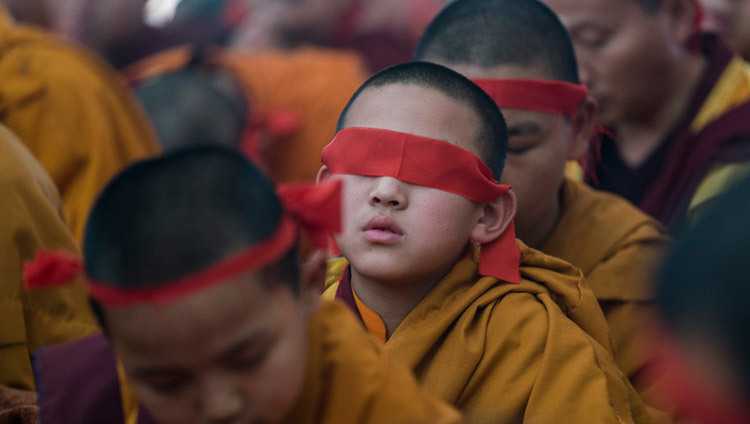부처님 가르침에 대한 설명
불교는 소승 불교(히나야나: Hinayana)와 대승 불교(Mahayana: 마하야나)으로 나눌 수 있으며 소승 불교 수행자는 성문(Shravakas: 자신의 해탈만을 목적으로 하는 출가 수행자)과 연각(Pratyekabuddhas: 깨달았지만 적정한 고독을 좋아하여 설법 교화하지 않는 성자)으로 나눌 수 있다. 성문과 연각은 능력과 성취한 결과의 수준에 따라 구분을 할 수 있겠지만 교리적 특징은 기본적으로 같다. 소승의 이 두 수행자들은 자신의 해탈을 우선 과제로 삼는다. 윤회의 고리를 한시라도 빨리 끊어야 한다는 급박한 마음을 가지고 있기 때문이다. 윤회의 굴레에서 집착을 일으키는 주된 원인은 ‘자아가 있다’는 생각 때문이다. 해탈의 자유를 얻는 주된 조건이 자아가 없음을 깨닫는 지혜라고 생각한다. 성문과 연각은 보살과 마찬가지로 무아를 깨닫는다. 그들은 지계, 선정의 길을 걸으면서 무아를 명상하여 모든 욕망, 욕심, 증오, 무지에서 벗어난다.

소승 불교 수행자들은 부처의 경지에 이르는 데 매진하지는 않지만 그들이 걷는 길 역시 마지막에는 부처의 경지에 이른다. 따라서 소승 불교의 길이 깨달음에 이르는 데 장애가 된다는 오해를 하지 말아야 한다. 법화경은 물론 다른 경전에서도 소승 불교의 길 역시 성불하는 길이라는 가르침이 나온다. 부처님이 이 세상에 출현한 이유는 다른 중생들로 하여금 자신이 증득한 깨달음에 이르도록 하기 위해서이다. 부처님이 가리키는 길은 오로지 중생들이 부처의 경지에 이르도록 하는 방법이다. 소승 불교의 길이 성불로 곧바로 연결되는 것은 아니지만 가르침에 의하면 소승 불교의 수행자들 역시 결국 대승에 이르며 성불한다.
소승 불교 수행자들이 대승 불교 수행자들과 마찬가지로 모든 현상에 실체가 없음을 깨닫기는 하지만 소승 불교와 대승불교에 차이점이 전혀 없는 것은 아니다. 대승 불교의 교리는 현상의 실체 없음만 조명하지 않고 보살의 단계, 바라밀, 모든 중생을 구제하기 위해 바르고 원만한 깨달음(정변지)을 얻도록 하는 기도, 대자비심 등을 가르친다. 또한 깨달음에 이르기 위해 헌신적으로 공덕을 쌓는 수행, 공덕과 반야를 모두 쌓는 수행, 모든 불선(不善)이 정화된 불가사의한 세계에 대해서도 가르친다.
따라서 대승 불교와 소승 불교는 철학적인 견해 차이로 구분된다기 보다는 전체적인 방편에 있어서 어떤 수행법을 선택하는가에 따라 구분된다. 이와 관련해서 나가르주나(용수 보살)와 제자인 아리야데바(제바)는 다음과 같이 설명한다. 어머니는 자신이 낳은 모든 자녀의 공통적인 모태가 되고 아버지는 인류를 구분 짓는 원인이 된다. 완벽한 지혜를 상징하는 어머니가 모든 자녀를 태어나게 하는 공통된 원인이 되며 네 종류의 성인 - 성문, 연각, 보살, 부처로 나눌 수 있다. 이들을 특정하게 소승 불교와 대승 불교 계통을 나누는 기준은 보리심을 일으키기 위한 방편의 유무이다.
일반적으로 대승 불교는 소승 불교와 마찬가지로 일반적으로 둘로 나눈다. 그것은 바라밀승(Paramitayana: 현교, 바라밀승)와 금강승(Mantrayana: 밀교)이다. 대승 불교는 모든 중생을 구제하려는 목적으로 위없는 깨달음을 얻기 위해 육바라밀 수행을 하는 공통적인 목표가 있다. 이러한 목표가 금강승에도 적용된다는 것은 분명하다. 진언 속에 담긴 가르침과도 일치한다. 그러나 바라밀승을 따르는 대승 불교 수행자들은 일반적으로 제시되는 방법만을 따르는 반면 금강승 수행자들은 바라밀승의 가르침에 포함되지 않는 특별한 진언을 이용하여 육바라밀을 수행을 한다.

The terms "Cause vehicle", "Paramitayana", and so forth are synonyms, and "Mantrayana", "Vajrayana", "Effect vehicle", and "Method vehicle" are synonyms as well. There is a difference between the cause vehicle and the effect vehicle: the cause vehicle is the Mahayana vehicle in which there is no meditation on oneself having a like aspect with any of the effects-the four complete purities-during the period of the path of training. The Mahayana vehicle in which there is meditation on oneself as having a like aspect with the four complete purities during the period of the path of training is called "The Effect vehicle" or "The Mantrayana". This is what the master Tsongkhapa said in the Ngag Rim Chenmo: "With regard to vehicle, since it is the vehicle of, i.e., conveys, the effect that is desired here and the cause that desires this, it is called 'vehicle'. The effect is the four complete purities of abode, body, property, and activities, a buddha's palace, body, wealth, and deeds. One meditates from the present on oneself as having a divine mansion, a divine entourage, divine ritual implements, and the divine deeds of purifying the cosmos and its inhabitants, just like a Buddha, Thus, it is the Effect Vehicle because one progresses through meditating in accordance with the vehicle of the effect."
Thus, the Mahayana as a whole is divided into the Paramitayana and the Mantrayana because these two have substantially different means for achieving a Buddha's Form Body that accomplishes the aims of others. In general, the Hinayana and the Mahayana are not distinguished according to any difference in their wisdom of emptiness, but must be distinguished due to differences in their methods, as mentioned above. In particular, although the Mahayana is divided into the Paramitayana and the Mantrayana, this is not due to any difference in their wisdom that realizes the profound emptiness; the two Mahayana systems must be distinguished from the point of view of differences in their methods. The main aspect of method in the Mahayana is the portion dealing with achievement of the Form Body, and the method that achieves the Form Body in the Mantrayana is just the deity yoga of meditating on oneself as having an aspect similar to that of a Form Body. This method is superior to the method employed in the Paramitayana.
With regard to the disciples of the Mantrayana, there are four types: inferior, middling, superior, and most excellent. The four classes of tantra were taught with these four types of disciples in mind. Since the disciples enter the Mantrayana through the four classes of tantra, the four classes are likened to "four doors." Should you wonder what the four are, they are Ritual Tantra, Conduct Tantra, Yoga Tantra, and Unexcelled Yoga Tantra. The Kalachakra, which will be described below, belongs to the Unexcelled Yoga Tantra class.
An Account of the Kalachakra, or Wheel of Time
The entire meaning of the subject matter of the Kalachakra tantra is included within the three Kalachakras, or Wheels of Time: The Outer Wheel of Time, the Inner Wheel of Time, and the Other Wheel of Time. The Outer Wheel of Time is the external world of the environment, and it is also called "The procession of the external solar and lunar days." The Inner Wheel of Time is the human body, that is an inner Jambudvipa, or earth-surface. Likewise, the inner channels, elements, and movements of the winds are set forth as the Inner Wheels of Time. The Other Wheel of Time is the initiations and paths of Shri Kalachakra, together with their results. It is "other" than the preceding two Wheels of Time. The guru ripens the disciple's psycho-physical continuum with the initiations, and the disciple meditates on the path that consists of the generation process and the completion process. In this way the yogi actualizes the resultthe buddha body that is the divine image of emptiness. This is the Other Wheel of Time.

The Buddha's teaching of the Kalachakra is described in the Paramadibuddha, the Kalachakra, Basic Tantra:
"As the teacher demonstrated the Dharma on Vulture Heap according to the Perfection of Wisdom system, he also taught the mantra system at Shri Dhanyakataka. What teacher taught what tantra, when and where was he dwelling? What was the place, who was the worldly entourage, and what was the purpose?
"He taught the unexcelled Mahayana, the system of the Perfection of Wisdom, to the bodhisattvas on Mount Vulture Heap. Then at the same time the Tathagata dwelt together with bodhisattvas and others in the great stupa, in the mandala of the sphere of phenomena. He dwelt in the house of universal vajra, in space, immaterial and very lucid, unpartitioned and radiant. He taught the tantra in the beautiful sphere of phenomena, for the merit and gnosis of human beings."
The Basic Tantra also says: "Then Vajrapani's emanation, King Suchandra from famous Shambhala, miraculously entered into the splendid sphere of phenomena. First he circumambulated to the right, then he worshipped the teacher's lotus feet with flowers made of jewels. Placing his hands together, Suchandra sat before the perfect Buddha. Suchandra requested the Buddha for the tantra, redacted it, and taught it too."
The Kalachakra was taught by our teacher, the Buddha Shakyamuni. He showed the way of actualizing highest perfect enlightenment underneath the bodhi tree at Bodh Gaya in India, at early dawn on the full moon of April/May. For one year he taught the general Paramitayana. In particular, at Mount Vulture Heap he turned the Dharma Wheel of the Perfection of Wisdom, the chief, ultimate Dharma Wheel of the Paramita system of the Mahayana.
On the full moon of March/April, the twelfth month counted from the time he obtained buddhahood, the Buddha was teaching the Paramitayana at Mount Vulture Heap. At the same time he manifested another form inside the great stupa of Shri Dhanyakataka, which is near Shri Parvata in south India where he taught the Mantrayana.
The great stupa was more than six leagues from top to bottom, and inside it the Buddha emitted two mandalas: below the mandala of Dharmadhatu Vagishvara, above the great mandala of the splendid asterisms. The Buddha was in the centre on the Vajra lion throne in the great Mandala of the Sphere of Vajra, the abode of great bliss. He was absorbed in the Kalachakra samadhi, and stood in the form of the Lord of the mandala.
The excellent entourage within the mandala consisted of a host of Buddhas, bodhisattvas, furies, gods, nagas, and goddesses. Outside the mandala the requestor was the emanated body of Vajrapani, King Suchandra of Shambhala. He had miraculously come to Shri Dhanyakataka from Shambhala, and he requested the Kalachakra for the entourage of listeners: the ninety-six emanated satraps of the ninety-six great lands within Shambhala, together with a limitless host of fortunate bodhisattvas, gods, demons, and others.

The Buddha gave the assembly the excellent Dharma-the worldly and transcendental initiations-and prophesied that they would obtain buddhahood, then he taught them the Paramadibuddha, the twelve thousand verse Kalachakra Basic Tantra. King Suchandra wrote it down in a volume and miraculously returned to Shambhala.
In Shambhala Suchandra composed a sixty thousand-line commentary of the Basic Tantra. He also erected a Kalachakra mandala made of precious substances. After he had appointed his son Sureshvara as King and teacher of the tantra, he passed away. Many great Kings appeared in the dynasty of Shambhala: Kalki Yashas, Kalki Pundarika, and others. They caused the profound Dharma of the Kalachakra to shine like the sun and the moon.
The Kalachakra continued to be transmitted through the succession of kalkis ("chieftains") of Shambhala, and eventually it was reintroduced into India. There are two main stories of how this came about, the story told by the Ra tradition and the story of the Dro tradition. (The Ra tradition and the Dro tradition will be discussed below).
According to the Ra tradition, the Kalachakra and related commentaries famed as the Bodhisattvas Corpus appeared in India during the simultaneous reigns of three kings. Taking Bodh Gaya as the center, the three kings were: Dehopala, the Master of Elephants, in the East; Jauganga, the Master of Men, in the South; and Kanauj, the Master of Horses, in the West. At that time the great pandit Cilu, who mastered all aspects of the Buddhadharma, was born in Orissa, one of the five countries of eastern India. Cilu studied all the Buddhist texts at the Ratnagiri Vihara, Vikramashila, and Nalanda. In particular, he studied at the Ratnagiri Vihara that was undamaged by the Turks.
Cilu realized that, in general, in order to achieve buddhahood in a single lifetime he would need the Mantrayana, and in particular, that he would need the clarifications of these doctrines contained in the Bodhisattva commentaries. Knowing that these teachings were extant in Shambhala, and depending on the instruction of his deity, he joined up with traders who sought jewels in the ocean. Having agreed with the traders, who were setting out across the sea, to meet up after six months, they went separate ways.
Cilu proceeded in stages and finally, upon climbing a mountain, he met a man. The man asked him, "Where are you going?" Cilu replied, "I am going to Shambhala in search of the Bodhisattva Corpus." The man said, "It is extremely difficult to go there, but if you can understand it, you could listen to it even here." Cilu realized that the man was an emanation of Manjushri. He prostrated, offered a mandala, and requested instruction. The man conferred all the initiations, tantra commentaries, and oral instructions on Cilu. He grasped Cilu, placed a flower on his head, and blessed him, saying, "Realize the entire Bodhisattva Corpus." Thus, like water poured from one vessel into another, Cilu realized the entire Bodhisattva Corpus. He went back the way he had come and, meeting with the traders, he returned to Eastern India.

According to the Dro tradition, the Kalachakra was reintroduced into India by the master Kalachakrapada. A couple who practised the Yoga of Yamantaka performed the ritual for the birth of a son as it is taught in the Yamantaka Tantra, and had a son. When he grew up he learned that in the north the bodhisattvas themselves taught the Dharma, so he went to listen to them. With his psychic power the Kalki of Shambhala knew of the youth's pure motivation and enthusiasm for the profound Dharma. He knew that if the youth attempted to come to Shambhala it would endanger his life because of the waterless wasteland that takes four months to cross. Thus, the Kalki used an emanation body to meet the youth at the edge of the desert.
The Kalki asked the youth, "Where are you going, and why?" when the youth told him his intentions the Kalki said, "That road is very difficult. But if you can understand these things, couldn't you listen to them even here?" The youth realized that this was an emanation of the Kalki and asked him for instruction. Right there the Kalki initiated the youth, and for four months he taught him all the highest tantras especially the three Bodhisattva Corpus commentaries. Like a vase filled to the brim, the youth realized and memorized all the tantras. When he returned to India he became renowned as an emanation of Manjushri, and his name was "Kalachakrapada".
The Ra and Dro traditions say that the Kalachakra was introduced into India by Cilu and Kalachakrapada. The Kalachakra continued to be studied and practised in India, and it was eventually introduced into Tibet. Again, the Ra and Dro traditions are the two main lineages through which this occurred.
The Dro tradition started from the visit of the Kashmiri Pandit Somanatha to Tibet. Somanatha first arrived in Tibet at Kharag and stayed among the Ryo clan. For a fee of one hundred measures of gold Somanatha translated half of the great Kalachakra commentary, the Vimalaprabha, into Tibetan, but in the meantime he became displeased and stopped his work. He took the gold and his draft translation and went to Phan Yul drub. There Chung Wa of the Zhang clan took Somanatha as his guru, and Shayrabdrak of the Dro clan acted as translator. Somanatha and Shayrabdrak translated the entire Vimalaprabha.
The Dro tradition continued on to Lama ChöKu Özer. This lama mastered all of the teachings of the Dro clan, including the Kalachakra. His disciple was Lama Galo, who mastered both the Dro tradition and the Ra tradition and passed them on in a single combined lineage.
The Ra tradition started with Chorab of the Ra clan, the nephew of the famous translator Ra Dorjedrak who was born in Nyen Ma Mang Yul. Ra Chorab memorized and understood all the doctrines of the Ra clan. Then he wished to learn the Kalachakra, so he went to the centre of Nepal where he continuously served the Pandit Samantashri for five years, ten months, and five days. Samantashri explained all the Kalachakra texts and gave Chorab the initiations and oral instructions. Then Chorab invited Samantashri to Tibet where they carefully translated the Kalachakra tantra and its commentary, together with the auxiliary texts.

The Ra tradition continued through Ra Chorab's son and grandson, and it eventually came to Lama Galo, as mentioned before. Lama Galo passed on both the Dro and the Ra traditions, and his lineage continued through such masters as Buton Rinchendrub and Tsongkhapa. The study and practice of the Kalachakra based on the Ra and Dro traditions exists even today.
Practice of the Kalachakra tantra, like all Buddhist tantric systems, is based on first receiving the proper initiations. For the initiations to be properly given and received it is necessary that both the guru and the disciple have certain qualifications. The qualifications of the Mantrayana guru are described by Losang Chökyi Gyaltsen as follows: "He should have control over his body, speech, and mind. He should be very intelligent, patient, and undeceitful. He should know the mantras and tantras, understand reality, and be competent in composing and explaining texts". We are very fortunate that such gurus can be found even now.
The disciple should have experience of the three principal aspects of the Mahayana path: renunciation of samsara, bodhichitta, and understanding of emptiness. If the disciple has not actually experienced these, he or she should at least have intellectual familiarity with them and admiration for them.
The most important of the three aspects is bodhichitta, the primary motivation for taking the initiations. Lord Maitreya defined bodhichitta in his Abhisamayalankara: "Bodhichitta is the desire for true, perfect enlightenment for the sake of others". When applied to the specific circumstance of taking the Kalachakra initiations, the disciple should generate bodhichitta in the following manner: "For the sake of all sentient beings I must achieve the state of Shri Kalachakra. Then I will be able to establish all other sentient beings in the state of Shri Kalachakra as well". With this motivation one should take initiation.
The general aim of tantric initiations is that through the initiations the guru ripens the disciple's psycho-physical continuum. Here "ripening" means empowering the disciple to practise the yoga of the generation process and the completion process. In particular, the Kalachakra initiations empower the disciple to practise the yoga of the Kalachakra tantra, and, ultimately, to achieve the state of Shri Kalachakra.
There are eleven Kalachakra initiations: seven initiations of "entering like a child", three "exalted" initiations, and one "most exalted" initiation. Disciples who are temporarily intent on just the worldly siddhis (magical or mystical accomplishments) are given only the seven lower initiations. Those who are mainly interested in the transcendental siddhi of buddhahood are given all eleven initiations. The first of the seven initiations of entering like a child is the water initiation. This is analagous to a mother washing her child immediately after its birth. The second initiation is the crown initiation that is analogous. to the binding of a child's hairlocks. The third, ribbon initiation is analogous to piercing a child's ears and arraying it with ornaments. The fourth initiation, the vajra and bell initiation, is analogous to a child laughing and talking. The fifth initiation is the discipline initiation, it is analogous to the child's enjoyment of the five desirable sense-objects. Sixth is the name initiation, analogous to the naming of the child. The seventh, and final, initiation of entering like a child is the mantra authorization initiation. This initiation empowers the disciple to eliminate obstacles and to achieve the magic powers of pacification, gaining prosperity, subjugation, and destruction.

The three exalted initiations are as follows: the vase initiation is the gnosis of bliss and emptiness that arises from the disciple touching the consort's breasts. The secret initiation is the gnosis of bliss and emptiness that arises from the disciple savouring the bodhichitta, the wisdom-gnosis initiation is the experience of connate joy that arises from the disciple and consort themselves engaging in union.
The most exalted initiation is also called "the fourth initiation" or "the word initiation" The previous great wisdom-gnosis initiation empowers the disciple to achieve the eleventh bodhisattva stage. Then the guru symbolically indicates the Gnosis Body that is the integration of supreme unchanging great bliss and emptiness possessing the best of all aspects. Saying, "This is it", the guru bestows the fourth initiation on the disciple. This initiation empowers the disciple to obtain perfect buddhahood in the form of Shri Kalachakra.
Translated from the Tibetan and edited by John Newman Translator's note: 'or more information on the subjects touched on in this essay the reader is advised to see: Dalai Lama, Kalachakra Tantra Initiation Rites and Practices (London: Wisdom Publications, 1985), and Geshe Lhundup Sopa eral, The Wheel of Time: The Kalachakra in Context (Madison. Wisconsin USA: Deer Park Books, 1985).
Kalachakra Initiations by His Holiness the Dalai Lama (Date/Place/Attendance)
1. May 1954 / Norbulingka, Lhasa, Tibet / 100,000
2. April 1956 / Norbulingka, Lhasa, Tibet / 100,000
3. March 1970 / Dharamsala, Himachal Pradesh, India / 30,000
4. January 1971 / Bylakuppe, Karnataka, India / 10,000
5. December 1974 / Bodhgaya, Bihar, India / 100,000
6. September 1976 / Leh, Ladakh, India / 40,000
7. July 1981 / Madison, Wisconsin, USA / 1,500
8. April 1983 / Dirang, Arunachal Pradesh, India / 5,000
9. August 1983 / Tabo, Himachal Pradesh, India / 10,000
10. July 1985 / Rikon, Switzerland / 6,000
11. December 1985 / Bodhgaya, Bihar, India / 200,000
12. July 1988 / Zanskar, Jammu & Kashmir, India / 10,000
13. July 1989 / Los Angeles, California, USA / 3,300
14. December 1990 / Sarnath, Uttar Pradesh, India / 130,000
15. October 1991 / New York, New York, USA / 3,000
16. August 1992 / Kalpa, Himachal Pradesh, India / 20,000
17. April 1993 / Gangtok, Sikkim, India / 100,000
18. July 1994 / Jispa, Himachal Pradesh, India / 30,000
19. December 1994 / Barcelona, Spain / 3,000
20. January 1995 / Mundgod, Karnataka, India / 50,000
21. August 1995 / Ulaanbaatar, Mongolia / 30,000
22. June 1996 / Tabo, Himachal Pradesh, India / 20,000
23. September 1996 / Sydney, Australia / 3,000
24. December 1996 / Salugara, West Bengal, India / 200,000
25. August 1999 / Bloomington, Indiana, USA / 4,000
26. August 2000 / Kyi, Himachal Pradesh, India / 25,000
27. October 2002 / Graz, Austria / 10,000
28. January 2003 / Bodhgaya, Bihar, India / 200,000
29. April 2004 / Toronto, Ontario, Canada / 8,000
30. January 2006 / Amarvati, Andhra Pradesh, India / 100,000
31. July 2011 / Washington, DC, USA / 8,000
32. January 2012 / Bodhgaya, Bihar, India / 200,000
33. July 2014 / Leh (Ladakh), Jammu & Kashmir, India / 150,000
34. January 2017 / Bodhgaya, Bihar, India / 200,000












